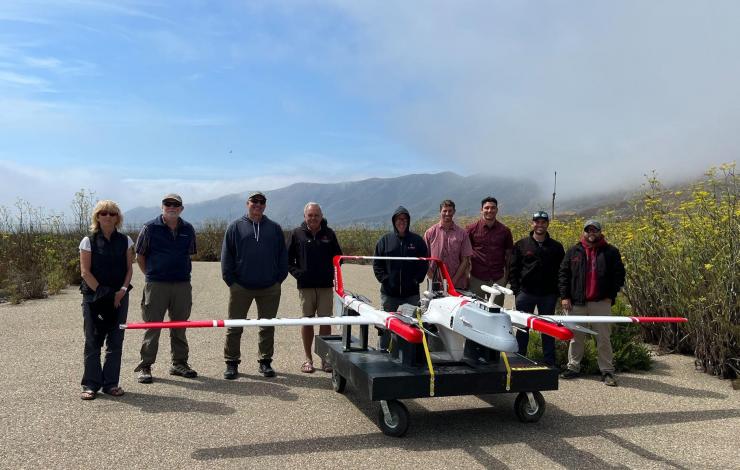July 17 to Aug. 4, 2023: A team of NOAA and industry uncrewed aircraft professionals conducted flight operations at Vandenberg Space Force Base in Lompoc, California, to expand and test the use of uncrewed aircraft to gather critical observational data. During the flight operations, NOAA’s Pacific Marine Environmental Lab (PMEL), the Uncrewed Aircraft Systems Division of NOAA's Uncrewed Systems Operations Center, and their industry partner Overwatch Aero tested PMEL’s science payloads onboard the hybrid FVR-90 Vertical Take Off and Landing - Fixed Wing uncrewed aircraft. The payloads, aptly named Clear Sky and Cloudy Sky, measure aerosol and cloud properties and the impact of aerosols on the Earth’s radiation budget.
These payloads can help NOAA address many areas of interest such as air quality, the role of aerosols in Earth’s energy budget, and atmospheric interactions. Aerosols are fine particles that are produced by waves breaking at the ocean surface (sea spray), phytoplankton (sulfate aerosol), sandstorms (dust), and combustion (burning of fossil fuels and wildfires). These microscopic particles can impact climate directly by absorbing or scattering incoming solar radiation and indirectly by affecting cloud properties such as extent, lifetime, and reflectivity. Aerosols also affect air quality by reducing visibility and, when inhaled, can affect our health. Deployment of these science payloads on uncrewed aircraft supports NOAA’s mission to understand and predict changes in climate, weather, the ocean and coasts.
The Vandenberg flight operations build on earlier efforts by NOAA to use uncrewed aircraft to measure aerosol and cloud properties. The FVR-55, a smaller counterpart of the FVR-90, was developed by L3Harris (previously Latitude Engineering, LLC) through NOAA’s Phase I and II Small Business Innovation Research awards.
In 2022, the smaller uncrewed aircraft conducted fully autonomous shipboard operations and beyond visual line of sight shore-based operations with the Clear Sky and Cloudy Sky payloads onboard. By using uncrewed aircraft launched from ships, NOAA is able to gather vertical profiles of aerosol and cloud properties more flexibly and efficiently than traditional sampling. Transitioning from the FVR-55 to the FVR-90 allows for longer duration flights and the addition of more instrumentation to the Clear and Cloudy Sky payloads.
During the flight operations, the uncrewed aircraft completed 15 flights and 46 hours of flight time in which the systems and science payloads were tested. Some flights lasted over four hours and at altitudes of 350-11,000 feet above sea level. The Clear Sky payload was flown up to 10,000 ft to identify aerosol layers in the atmosphere and to measure the absorption and scattering of solar radiation by those layers. Overall, the operations moved the team one step further in achieving their ultimate goal of launching the payloads onboard the FVR-90 from NOAA ships to complement surface measurements of aerosol properties.
The Atmospheric Chemistry Group at NOAA’s Pacific Marine Environmental Lab has been studying the effects of aerosols on climate and air quality by participating in shipboard national and international research field campaigns and long-term aerosol monitoring for over thirty years. Their work has employed the use of ships, uncrewed aerial systems (UAS), and ground stations. Learn more about the research conducted by PMEL's Atmospheric Chemistry Group on their webpage and watch a video highlighting the importance of the work.



